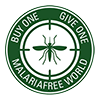Travel Health Group Malaria Impact Report 2024
Our BHAG (Big Hairy Audacious Goal): a malaria-free world by 2030
A bold ambition aligned with the goals of the WHO. For over 20 years, we’ve been dedicated to this mission—distributing mosquito nets where they’re needed most, educating communities on proper use, and supporting scientific research on the use of mosquito nets.
By 2030, we aim to multiply our impact tenfold. It’s a big goal, but one worth striving for. To get there, we’ve identified key pillars where we want to grow and make an even greater difference.
We invite you to scroll down to explore our these key pillars and contributions in 2024 and how we’re working towards a malaria-free world.
World Malaria Report
Every year, the World Health Organisation (WHO) publishes the World Malaria Report, which provides insights into the latest trends in malaria control and elimination at global, national and regional levels. The report describes progress towards global goals and describes opportunities and challenges in reducing and eradicating this disease.
Even though significant progress has been made in recent years, malaria remains a major global health challenge, affecting millions worldwide and significantly impacting human lives and socio-economic development.
Key results:
Globally, an estimated 2.2 billion cases and 12.7 million deaths have been prevented since 2000. In 2023 alone, more than 177 million cases and 1 million deaths were averted worldwide. As of December 2024, 44 countries and one region have been certified malaria-free by WHO.
However still, there were an estimated 263 million new malaria cases reported in 83 endemic countries or regions in 2023. The number of estimated deaths from malaria was 597,000 in 2023, down slightly compared the 600,000 deaths in 2022.
The African Region accounted for an estimated 94% of global malaria cases and 95% of malaria-related deaths in 2023. About two thirds of global malaria cases and deaths are concentrated in 11 African countries, amongst others Uganda. These countries have adopted the “High Burden High Impact” strategy that uses local data and disease patterns to deliver tailored interventions to the most at-risk populations. From 2015 and 2023, the African Region saw a 5% decrease in case incidence and a 16% decrease in mortality rates. However, rates in 2023 for both indicators were still more than twice the target levels set by the WHO global malaria strategy.
Positive news:
- Azerbaijan, Belize, Cabo Verde and Tajikistan were declared malaria-free in 2023, along with Egypt in October 2024 and Georgia in January 2025.
- The malaria vaccines RTS,S/AS01 (RTS,S) and R21/Matrix-M have been recommended by WHO for use in malaria endemic areas. Approximately 2 million children in Ghana, Kenya and Malawi received the RTS,S vaccine between 2019 and 2023. An 13% reduction in all-cause mortality and a 22% reduction in hospitalizations of severe malaria among children age-eligible for vaccination was seen during this period.
Less good news:
- The WHO global malaria strategy aims at, amongst other goals, to reduce malaria incidences and death rates of at least 75% by 2025 and 90% by 2030 compared to the 2015 baseline levels. However unfortunately, the 2023 global malaria incidence rate of 60.4 cases per 1.000 population at risk is almost three times higher than the 21.3 cases per 1.000 needed to reach the target. Furthermore, there were 13.7 malaria deaths per 100.000 population at risk in 2023, more than twice the target of 5.5 deaths per 100.000.
- Humanitarian emergencies can displace populations and negatively affect healthcare systems. In 2023, an estimated 80 million people in malaria-endemic countries were internally displaced persons (IDPs) or refugees. IDPs and refugees often lack access to malaria prevention or treatment. Especially women, children and marginalized communities are disproportionately affected as they are often residing in camps or shelters without adequate malaria control, leading to higher exposure and transmission rates.
- Climate change continues to threaten progress in the fight against malaria, as rising temperatures and shifting rainfall patterns are impacting the health, security and livelihoods of people all around the world. The effects of climate change on malaria is particularly pronounced in regions already burdened by poverty, inadequate health infrastructure and limited access to resources. This not only increases the risk of disease exposure, but also widens existing inequalities. According to the World Health Organization, climate change is the single greatest threat to human health, and its influence on malaria is already being observed across multiple regions.
The WHO has declared climate change the primary health threat facing humanity. Rising temperatures, changed rainfall patterns and humidity can create favourable conditions for the increase in mosquito populations, expanding their geographic reach and escalating the rate of transmission. Additionally, these conditions can also result in the formation of breeding environments favourable for mosquitoes and worsening the dynamics of disease transmission.
The impact of climate change on malaria is particularly pronounced in regions already burdened by poverty, inadequate healthcare infrastructure and limited access to resources, further increasing the risks of harmful exposure to diseases and widening existing inequalities.
The latest numbers
malaria cases in 2023
malaria deaths in 2023**
Nets distributed (2024)*
*with our 2024 outreach in Uganda.
** Source: WHO. While the report does not provide specific estimates for 2024, it notes that the number of malaria deaths in 2023 was nearly the same as in 2022, indicating a plateau in progress.
Our contribution in 2024
Pillar 1: Increasing the number of nets deployed
Mosquito nets remain one of the most effective tools in the fight against malaria. Our nets are locally sourced and printed in Kampala, Uganda. From there, they are distributed through various partners and personally handed out to those who need them the most.
How our team experienced their visit to Uganda in October 2024
Amber & Sandra about the outreach
“We went to the outreach yesterday—it was a joint effort with Rotary. We kicked things off in the morning. It was a medical outreach, so besides handing out mosquito nets, we also gave out medicine. The line was super long—people came from really far away, from what we could tell. It was amazing to see how many showed up. And Sandra, what caught your attention?”
Amber
“Yes, there were definitely long lines—so yes, a lot of people, including families with little kids. But the flow was actually pretty good. People sat on chairs while they waited, and then they went for a medical checkup. After that, a dentist also checked them, and they had some tests done—like blood tests to see if they had malaria. If they did, they went through to the next station to pick up medicine. And after that, they got their mosquito net.”
Sandra
“Sure, 100%. And we actually got quite a few respondents for our research interviews. We asked things like – how do you use the net? How many people sleep under it? Would you like it if the net had a print? I was really able to reach out to a lot of people there, and we’re hoping to get more insight into how they actually use the net.”
Amber
Emmeline & Pria about the outreach
“Yesterday we kicked off the day with the outreach—that was really the day we came here for. We arrived at the Health Center where it was taking place, and what we saw there was actually a really nice setup. People had already shown up early in the morning to be part of the outreach. Next to that field was the Health Center itself. What I found really special was how eager people were to get a net—they actually walked all the way there just for that. We even heard that some people got up in the middle of the night to make sure they’d be there on time.
Emmeline
“Yeah, there was actually a really nice structure to it, right? People would arrive and take a seat first. Then they’d start with the health check, go to the dentist after that, and then get tested for malaria through a blood test. Once that was done, they could pick up any medicine they needed, and finally, they’d receive a net. And if they got a net, they also did a short interview afterwards.”
Pria
“That was part of the research they set up to see how the nets are actually being used. So some people got plain nets and others got printed ones, just to see if that makes a difference in how people use them. The research team on the ground was also doing interviews—both with people who received a printed net and with those who got a plain one. And in a few months, they’re going to follow up with those same people to check how they’ve been using the nets. I thought that was really well organized.”
Emmeline
Amber & Sandra visited a local village
“Today we visited the local community. David from the Rotary Club had arranged for us to see how the mosquito nets are actually being used. It was a powerful experience. As we drove into the village, we saw the huts where people live, and children playing happily outside – having fun with so little. But when you realize how small the spaces are, and that some even live in tents… it really touches you. Still, it was meaningful to be welcomed in and to witness firsthand how they use the nets.”
Sandra
“The children were so creative – they turned plastic bags into footballs, or made skipping ropes out of random strings. And that little one pulling a jerrycan behind them like a sled? They really make use of everything they have. You could see that with the nets too. One large net was wrapped around a tree, stitched together and used to store plastic bottles. But what I personally found meaningful was seeing the printed net, the one with the women’s design, hanging above the bed inside a home. That’s exactly what we hope for and work towards.”
Amber
“One of the daughters of the woman who showed us the house with the bed was cooking in the corner – that space was so small that the net had to be folded up while she cooked. She told us that once she finishes cooking, she puts the net back around the bed. And then her daughter suddenly wrapped her arm around me and said, ‘How are you doing, madam?’ It was such a small gesture, but it really touched me.”
Sandra
Emmeline & Pria visited a local village
“Today, we visited the village where the local community lives, to see how they live and how they use the nets there. David told us that a street had burned down recently, and that the people are now living in tents while they rebuild their homes. So we walked around to get a sense of daily life there. What really stood out to me was how close-knit everyone seemed. You could really see how much they support each other, and all the children were happily playing together. Even though they’ve been through something so difficult with the fire and are now living in tents, they still manage to make the best of each day together. That’s the feeling I got — that sense of strong community. I’m curious Pria, how did you experience it?.”
Emmeline
“Yes, I noticed that too. And it was really striking how the children, with the few things they have, could still come up with fun games and enjoy themselves.”
Pria
“Yes, it was also nice to see how they continue playing together and spending time with each other. What I also thought was beautiful: in one of the tents we saw a woman had already hung up a mosquito net, which was great to see. After that, we walked further into the village to visit the street where the fire had happened. We were even allowed to visit a few people inside their homes to see how they’re using the nets now. Because of the fire, there was an outreach effort in October to distribute mosquito nets to the affected families. And we could really see how they had put up the nets. What I found really touching was one woman in particular — she was so happy with her net and proudly showed it to us, even pointing out the picture printed on it. It was neatly hung over her bed, just as it should be. It was really nice to see how gratefully and carefully they’re using the nets.”
Emmeline
Pillar 2 – Increase knowledge on net usage
Our nets are intentionally printed with familiar images—such as animals, football stars or other motivational visuals. Research shows that this approach encourages people to use the nets as intended for a longer period. People are less likely to repurpose the nets for e.g. fishing, fencing or poultry coops and instead use them as intended. To share these valuable insights more widely, we initiated a scientific study. This research is being conducted by the Travel Health Group in collaboration with Radboud University Nijmegen, led by Assistant Professor Thijs Verwijmeren. We initially began data the collection in 2023 with partner Survey54,
but this method proved less effective than expected. To ensure more reliable results, we chose a new local partner to conduct the interviews, The Field Lab based in Mbale. Led by Director Joshua Balungira.
- Drafting survey questions
- Coordinating with the Radboud University ethics committee
- Run pilot study
- Start of 3 research rounds
- Analyse results
- Drawing conclusions and publication
Performing research in these kind of rural area’s comes with challenges. We want to make sure that our data is as reliable as possible therefor at this point (April 2025), in consultation with Radboud University, for the next phase, it was decided to partner with a local university to ensure that the research would produce the most reliable analyses.
Pillar 3: Building the winning team
To deepen our employees’ connection to our mission, we decided in 2023 to involve THG employees directly in the outreach efforts in Uganda. This way, they could witness firsthand the impact of our commitment to a malaria-free world. As such, in November 2024, the first group of five THG employees joined an outreach initiative in partnership with Rotary Uganda on the Ssese Islands. Alongside distributing printed mosquito nets, various medications were provided and a dentist was available for necessary check-ups.
The journey left a lasting impression.. The team witnessed the profound impact our products have on lives and recognized the critical importance of prevention and access to care in the fight against malaria.
Pillar 4: Strengthening Partnerships
During the outreach in 2024, we met with the Join for Joy Foundation, which trains teachers in rural Uganda and other countries to use play-based learning in their classrooms. Following a successful first meeting, a pilot program is scheduled for February 2025, coinciding with the reopening of schools and the presence of parents. If the pilot is successful, Travel Health Group—in partnership with Meduprof-S—will develop educational toolkits to support teachers in education children about malaria prevention, symptoms, treatment and the proper use of mosquito nets.
Pillar 5: Advancing reporting & governance
Since 2000, we have actively contributed to the fight against malaria by donating 1% of the turnover from Care Plus®, Moustifluid and now also Primmed. In 2023, we optimised our donation model under the Travel Health Group banner to amplify our impact. As in previous years, this impact report provides transparency about our financial contributions and our ongoing commitment to our BHAG (Big Hairy Audacious Goal).
In the past years, we have seen a huge growth in the number of nets distributed. To raise awareness of the impact of malaria and meet our target, we invested in new footage. Together with local film crews, we filmed and photographed during two outreaches.
Malaria remains one of the most lethal diseases globally, significantly affecting human health, economic stability and national development. Despite being preventable and eradicable, it continues to pose a severe threat. If you are eager to contribute to our efforts or have suggestions or ideas to share, we welcome your input! Please don’t hesitate to contact us via the contact form.
Balance sheet 2024
| 2024 details | |
|---|---|
| Twiga nets | 72 K EUR |
| Dutch Malaria Foundation | 15 K EUR |
| Research Uganda | 2,75 K EUR |
| Publication costs awareness for malaria | 12 K EUR |
| Distribution costs of nets in Uganda | 5,951 K EUR |
| Total: | 107,701 K EUR |
| Reserve carried into 2025 | 17,3 K EUR |
Balance sheet 2023
| 2023 details | |
|---|---|
| Twiga nets | 69 K EUR |
| Dutch Malaria Foundation | 15 K EUR |
| Research Uganda | 12 K EUR |
| Publication costs awareness for malaria | 13,1 K EUR |
| Cost physical net distribution in Uganda | 1,6 K EUR |
| Total: | 110,7 K EUR |



